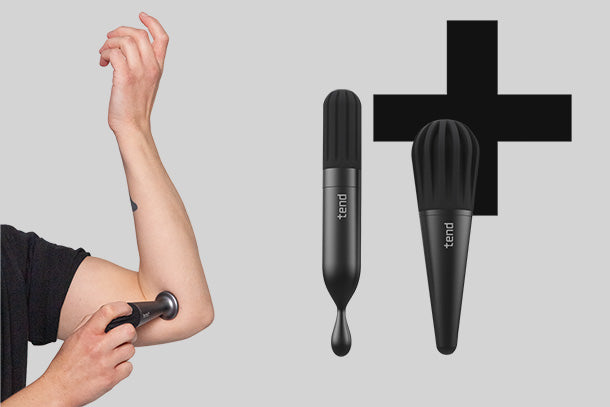Evidence - Research, FVT and more.
THE EVIDENCE
Tend is unique and new. As such no research exists specific to the device as yet (we are working hard on that)
Broadly TEND tools are a form of focal vibration therapy (FVT) This is a broad term that refers to both massage guns and devices fixed to the body, delivering vibration at a range of speeds, amplitudes etc.
This application of vibration, termed **focal vibration therapy (FVT)**, has been gaining scientific interest for its potential therapeutic benefits. While research is ongoing, existing evidence suggests FVT, delivered through vibration guns, may offer various advantages for muscle function, pain management, and rehabilitation.
References linked at the bottom of this page.
Understanding FVT
FVT differs from whole-body vibration (WBV), which involves standing or sitting on a platform that vibrates the entire body. FVT, on the other hand, focuses vibrations on specific muscles or groups of muscles using a handheld device with an oscillating head. This targeted approach allows for precise manipulation of the vibration frequency, amplitude, and duration tailored to individual needs.
Potential Benefits of FVT:
1. Improved Muscle Performance:
Studies suggest FVT can enhance muscle performance in various ways. Applying vibrations before exercise may increase muscle blood flow and activate the nervous system, potentially leading to improved strength and power output [4]. Additionally, FVT applied after exercise may facilitate muscle recovery by promoting blood flow clearance of metabolic waste products like lactate, potentially reducing muscle soreness and fatigue [5].
2. Pain Management:
FVT shows promise in managing pain through various mechanisms. The vibrations are thought to stimulate the release of endorphins, the body's natural pain-relieving chemicals [2]. Additionally, FVT may desensitize pain receptors, offering temporary relief from chronic pain conditions like arthritis and muscle tension [3].
3. Enhanced Neuromotor Function:
FVT may benefit individuals with neurological conditions like stroke or Parkinson's disease by stimulating the proprioceptive system, which provides information about body position and movement. This stimulation may improve balance, coordination, and muscle control [1].
4. Rehabilitation and Recovery:
FVT is increasingly being explored as a tool for rehabilitation following injuries or surgery. Studies suggest it may promote tissue healing, reduce muscle atrophy, and improve joint range of motion, aiding in the recovery process [6].
5. Flexibility and Myofascial Release:
FVT can be used to address tight muscles and fascial restrictions. The vibrations may help relax and lengthen muscle tissue, affecting local mechanoreceptors, potentially improving flexibility and range of motion [7].
Research and Considerations:
While the research on FVT is promising, it is crucial to acknowledge that the field is still evolving. Studies have shown varying degrees of effectiveness depending on factors like the specific condition, treatment parameters, and individual differences. More robust research is needed to fully understand the long-term efficacy and optimal protocols for various applications.
Conclusion
Vibration devices offer a convenient and potentially beneficial approach to FVT. While research is ongoing, the available evidence suggests these devices may hold promise for improving muscle function, managing pain, and aiding in rehabilitation. However, it is crucial to use it cautiously, and be aware of the limitations of current research. As the field evolves, FVT has the potential to become a valuable tool for promoting overall health and well-being.
What is the benefit of using Tend’s pinpoint tip
Pinpoint accuracy can be very helpful when treating tendon, joint and ligament pain because it allows for more precise targeting of the affected area. Tendons, joints and ligaments are often small and located in hard-to-reach areas, and accurate targeting can help ensure that the treatment is focused on the specific area where the pain is originating.
Overall, pinpoint accuracy can be an important tool in treating tendon, joint and ligament pain, as it allows for more targeted and effective treatment while minimizing potential side effects or complications.
What is the benefit of using different vibration patterns
One way that vibration patterns can impact the body is through the way they affect different aspects of physical function. For example, studies have shown that intermittent vibration can improve bone density, while continuous vibration can improve muscle strength. This means that healthcare providers can use different vibration patterns to target specific areas of physical function that may be deficient in a given patient.
Intermittent vibration, which involves short bursts of vibration separated by rest periods, has been shown to be particularly effective at improving bone density. This is thought to be because the vibration causes small changes in the body's gravitational loading, which can stimulate bone remodelling and the deposition of new bone tissue. Intermittent vibration has been shown to be effective in improving bone density in postmenopausal women and older adults, who are at increased risk for osteoporosis and bone fractures.
Continuous vibration, on the other hand, has been shown to be effective at improving muscle strength. This is thought to be because the vibration causes muscle contractions, which can lead to increased muscle activation and growth. Continuous vibration has been shown to be effective at improving muscle strength in a variety of populations, including athletes and older adults.
In addition to targeting specific aspects of physical function, different vibration patterns can also be used to tailor WBV treatment to the individual needs of patients. For example, patients who are recovering from an injury or surgery may benefit from a gentler vibration pattern, while athletes or individuals looking to improve their fitness may benefit from a more intense vibration pattern.
Conclusion
In conclusion, Tend is a handheld device that uses Focal Vibration Therapy to provide relief for muscle tension, pain reduction, and improved circulation. Its unique frequency and vibration patterns provide optimum results, and its pin-point tip allows for hard-to-reach areas to be accessed. There is evidence to suggest that Direct Vibration Therapy can be effective for certain conditions, including muscle pain and osteoarthritis. Studies have also identified that specific frequencies, such as 35 Hz and 50 Hz, may be effective in improving muscle strength, power, and balance. Overall, Tend appears to be a promising and innovative approach to Direct Vibration Therapy, with the potential to help people manage their physical conditions effectively.
Important Considerations Before Using Vibration Guns:
* **Consult a healthcare professional:** Before using any vibration device, especially if you have any pre-existing medical conditions, it is vital to seek guidance from a qualified healthcare professional. They can advise on the appropriateness and safe use of FVT for your specific needs.
* **Start gradually:** Begin with low intensity and short duration applications, gradually increasing as tolerated.
* **Listen to your body:** Pay attention to how your body responds to the treatment. Discomfort or pain is a sign to stop and consult a healthcare professional.
* **Choose the right device:** Select a vibration gun with adjustable settings for frequency, amplitude, and attachments to target different muscle groups effectively.
**References:**
1. Focal vibration in neurorehabilitation. Murillo N, Valls-Sole J, Vidal J, Opisso E, Medina J, Kumru H.. Eur J Phys Rehabil Med. 2014 Apr;50(2):231-42. PMID: 24842220.: [https://pubmed.ncbi.nlm.nih.gov/34225557/]
2. Effectiveness of Focal Muscle Vibration in the Recovery of Neuromotor Hypofunction: A Systematic Review. Fattorini, L.; Rodio, A.; Filippi, G.M.; Pettorossi, V.E. J. Funct. Morphol. Kinesiol. 2023, 8, 103. https://doi.org/10.3390/jfmk8030103
3. The emerging role of focal muscle vibration in rehabilitation of neurological disorders: [https://pubmed.ncbi.nlm.nih.gov/24842220/](https://pubmed.ncbi.nlm.nih.gov/24842220/)
4. Focal Vibration Therapy: Vibration Parameters of Effective Wearable Devices Ghazi, M.; Rippetoe, J.; Chandrashekhar, R.; Wang, H.. Appl. Sci. 2021, 11, 2969. https://www.mdpi.com/2076-3417/11/7/2969
5. Is the Focal Muscle Vibration an Effective Motor Conditioning Intervention? A Systematic Review.[Fattorini, L.; Rodio, A.; Pettorossi, V.E.; Filippi, G.M. J. Funct. Morphol. Kinesiol. 2021, 6, 39. https://www.mdpi.com/2411-5142/6/2/39
More Research
Rittweger J, Mutschelknauss M, Felsenberg D. Acute changes in neuromuscular excitability after exhaustive whole body vibration exercise as compared to exhaustion by squatting exercise. Clinical Physiology and Functional Imaging. 2003;23(2):81-86. doi: 10.1046/j.1475-097x.2003.00488.x https://onlinelibrary.wiley.com/doi/abs/10.1046/j.1475-097x.2003.00488.x
Verschueren SMP, Roelants M, Delecluse C, Swinnen S, Vanderschueren D, Boonen S. Effect of 6-Month Whole Body Vibration Training on Hip Density, Muscle Strength, and Postural Control in Postmenopausal Women: A Randomized Controlled Pilot Study. Journal of Bone and Mineral Research. 2004;19(3):352-359. doi: 10.1359/JBMR.0301245 https://asbmr.onlinelibrary.wiley.com/doi/abs/10.1359/JBMR.0301245
Rittweger J, Beller G, Armbrecht G, et al. Prevention of Bone Loss During 56 Days of Strict Bed Rest by Side-Alternating Resistive Vibration Exercise. Bone. 2010;46(1):137-147. doi: 10.1016/j.bone.2009.09.015 https://www.sciencedirect.com/science/article/abs/pii/S8756328209005396
Liu C-J, Latham NK. Progressive resistance strength training for improving physical function in older adults. Cochrane Database of Systematic Reviews. 2009;(3):CD002759. doi: 10.1002/14651858.CD002759.pub2 https://www.cochranelibrary.com/cdsr/doi/10.1002/14651858.CD002759.pub2/full
Galloway SD, Watt JM. Massage provision by physiotherapists at major athletics events between 1987 and 1998. Br J Sports Med. 2004;38(2):235-237. doi: 10.1136/bjsm.2002.002220 https://bjsm.bmj.com/content/38/2/235


